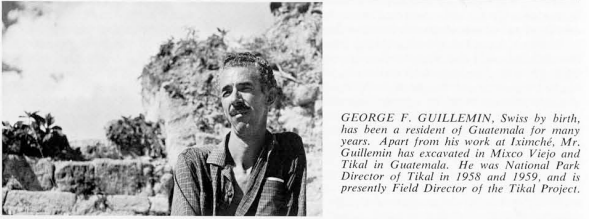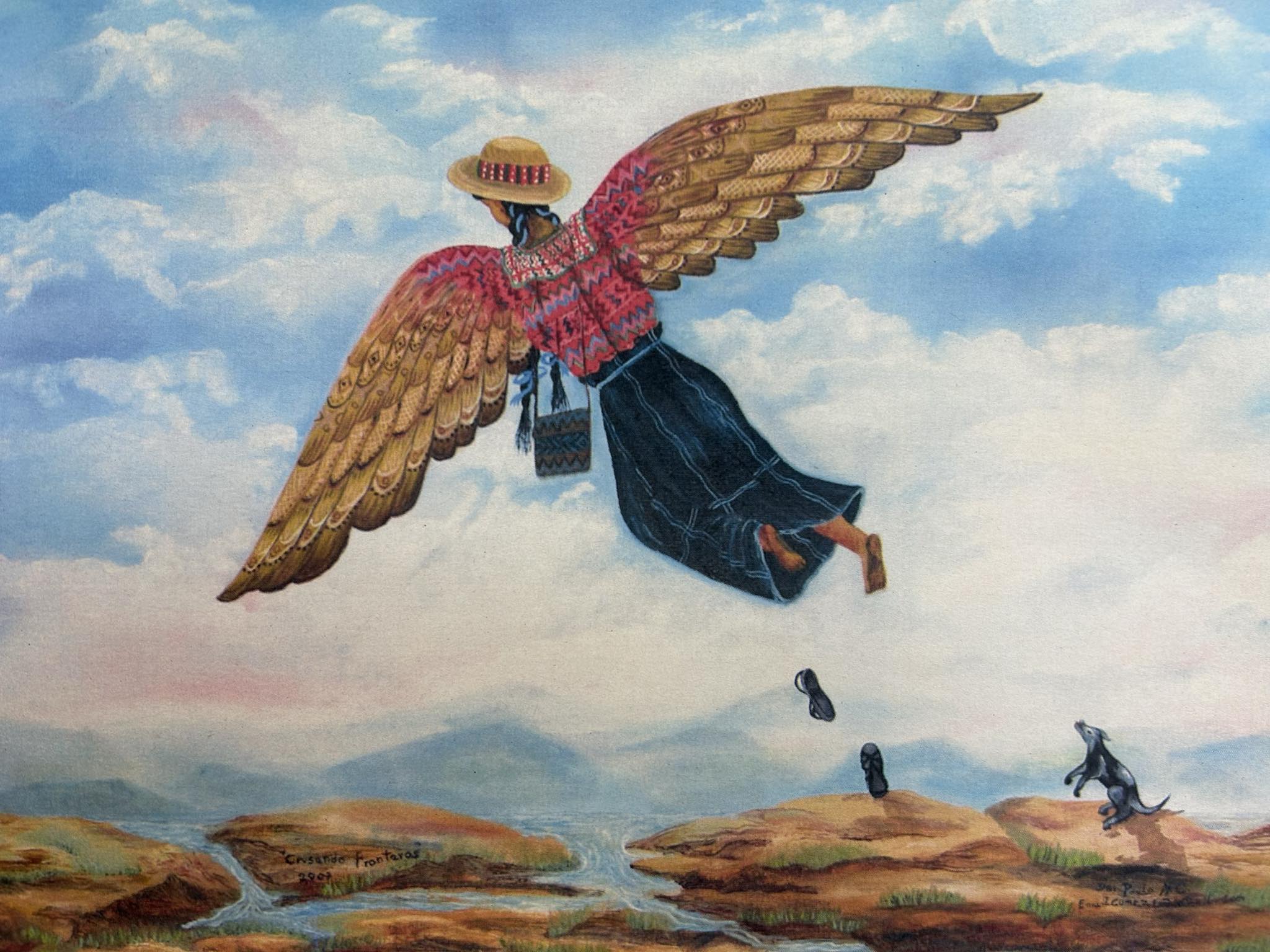
国境を越える
Crossing Borders, by Paula
Nicho Cúmez, 2007
☆ 先住民の女性が、自分を縛っていた境界を越えて飛び立つ。 パウラ・ニコ・クメスの2007年のこの絵画のイメージは、何世紀にもわたってマヤの女性を抑圧してきた貧困、暴力、差別を克服する女性の 姿を暗示している。クメスはカクチケル先住民であるが、この絵の民族衣装は、トドス・サントス・クチュマタンの女性のものである。
| Crossing Borders Oil on canvas 2007 An indigenous woman takes flight, transcending the boundaries that have held her back. Rising into the air, still dressed in her traje, her native dress, the woman retains her identity—her culture. This image suggests a woman overcoming the poverty, violence, and discrimination that have oppressed Maya women for centuries. It may also refer to immigrant women crossing the frontiers on their way to a new life in Mexico or the US. For such a journey much is left behind. In the painting, the woman loses a shoe, and the small dog, perhaps standing for her family, runs after the woman. The risks are great. Who knows when she will be able to see or talk to her loved ones again? Millions of Maya have fled to Mexico, and tens of thousands have come to the US seeking jobs and refuge from continuing violence. All of Paula Nicho Cúmez’s paintings include symbolism. Paula draws her themes from her dreams and from her life as a Mayan and a woman. Maya Woman, The Helen Moran Collection |
Crossing Borders(国境を越える)キャンバスに油彩 2007 先住民の女性が、自分を縛っていた境界を越えて飛び立つ。このイメージは、何世紀にもわたってマヤの女性を抑圧してきた貧困、暴力、差別を克服する女性の 姿を暗示している。 このイメージは、何世紀にもわたってマヤの女性たちを抑圧してきた貧困、暴力、差別を克服する女性を暗示している。また、メキシコやアメリカでの新しい生 活に向けて国境を越える移民の女性たちを指しているのかもしれない。そのような旅には、多くのものが置き去りにされる。絵の中で、女性は靴を失い、小型犬 はおそらく家族のために立っているのだろう、女性を追いかけて走る。リスクは大きい。 何百万人ものマヤがメキシコに逃れ、何万人ものマヤが仕事と続く暴力からの避難を求めてアメリカに渡っている。 パウラ・ニコ・クメスの絵画はすべて象徴主義を含んでいる。ポーラは夢から、そしてマヤ人として、女性としての人生からテーマを引き出している。 |
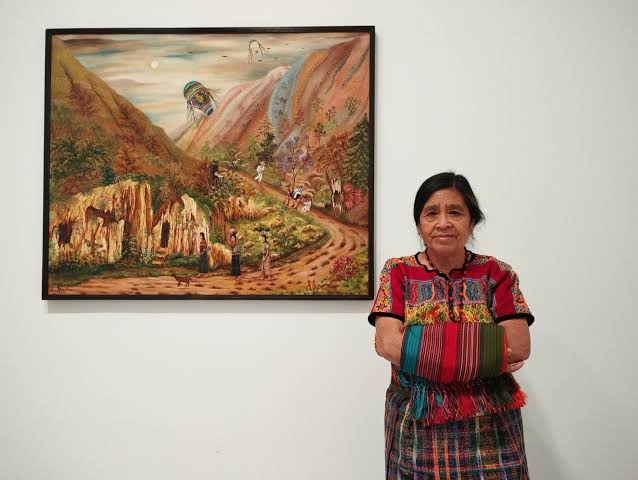 Paula Nicho Cumez (born January 15, 1955) is a Mayan-Guatemalan artist. Cumez is inspired by Mayan tradition and culture and focuses on expressing the context of native women’s experience in her artwork; additionally, Cumez was inspired by the Popol Vuh.[1] Cumez is known for creating an artist community of women within the Tz’uthil Mayan artists, named "Kaqchikel Surrealist Painters.” Additionally, a short film was made about Paula Nicho Cumez’s background called Del Azul al Cielo.[1]  Goddess Ixchel: Mayan deity who is known to weave for the people in order to create flourishing agriculture for the people. Ixchel also represents fertility. In Cumez's works, the goddess is depicted sowing and threading the soil and natural environment as a reflection of the Ichzel's role in the day-to-day life of people. Ixchel is usually depicted in natural settings and kneeling in the earth as a representation of her connection to earthly fertility. 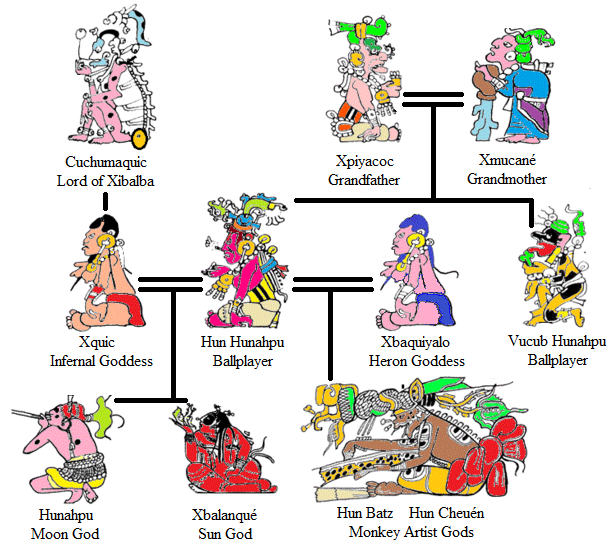 The Popul Vuh: A text which is foundational to the understanding of Mesoamerican mythology, theology, and cosmology. The text explains the Mayan understanding of creation and the important deities that arose successively from the dating back to the origin of creation. Biography & Tz'utujil Foundations Paula is a self-proclaimed Mayan and Guatemalan artist who was a weaver before she became a painter, and whose influence stems from both her contemporary culture and ancestry. Through the encouragement of her grandfather Francisco Cumez (a sculptor himself) to develop her artistic skills and learning from her teacher and future-husband Salvador Cumez Currichich, she began her career at thirty years old in 1985. Paula Nicho Cumez is an artist from the town of San Juan Comalapa and is part of a greater Tz’utujil Mayan artist community. Cumez’s husband, Salvador Cumez Currichich, is also an artist from the same community. Another artist that is internationally known that is from this same town is Andrés Curruchich. Regardless, an interesting distinction between the male and female artists of this community that one should acknowledge is: that where male artists focus more on ritual processions, female artists focus on surrealism.[2] Cumez identifies with her Maya Kaqchikel culture, and this is demonstrated through her various artworks.[3] There are four cities which compose the Tz’utujil: (1) San Pedro de la Laguna, (2) Santiago Atitlán, (3) San Juan de la Laguna, and (4) San Juan de la Comalapa. However, the art from where Cumez’s was raised is in key ways different from the others, as this city is the only one that does not surround Lake Atitlán.[4] Artworks Cumez's work is attributed with surrealist artistic types, and many view her works as being reflective of art naif [5][1](native art). Many of her works are oil on canvas. One of her more prominent works is, Processo y Visión de los Acuerdos de Paz (2007) which depicts the goddess Ixchel and El Principio de Una Nueva Era (2012) which represents the end of the indigenous Baktun 5,125 cycle. Additionally, Corazon del Maiz (2004) is an oil on the wood painting which is cited in scholarly works. In the introduction section titled "Mayan Women as History," the artwork is used as a way to discuss a contemporary Central American exploited agricultural economy and how this affects working-class labour opportunities in third world countries.[6] To see her works you can visit the following websites: 1 Arte Maya and Novica. Author and researcher Staikidis in regards to Cumez's work state, "the paintings become visual metaphorical windows into Mayan Kaqchikel female cultural worlds." Furthermore, this can be seen through artworks that carry these motifs such as, Mi Segunda Piel which is a series of two painting one made in 2002 and one made in 2004. 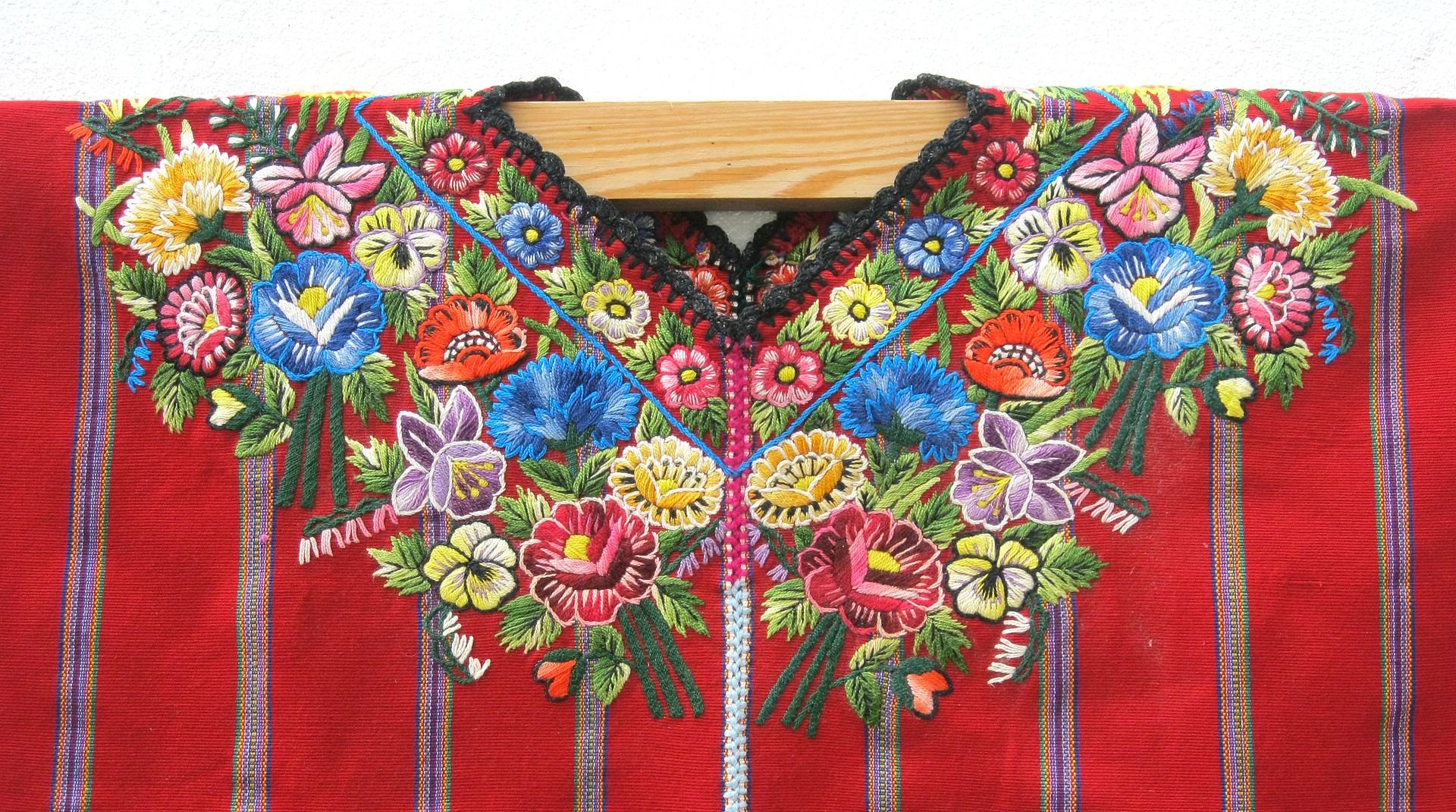 Guipils: these are traditional and indigenous clothes which are used by the women specifically in Tz'utujil Mayan culture.[2] Regardless they are typical Guatemalan garments with a variety of floral designs and bright colours. The artworks reflect the narratives of Mayan-indigenous culture in Guatemala, and by creating narratives in the story there is a sense of individualized and embraced Tz’utujil Mayan identity. The use of weaving as a motif of female authorship and ownership is seen throughout the works: for example, the Mother Nature (1995) with the mountains substituted as guipils.[2] The use of guipils and the acts of weaving relate to not only Cumez's upbringing but Mayan cosmology such as to Ixchel (which is also incorporated in her works). This indigenous clothing appears in works such as Canto a La Naturaleza, Nuestra Madre Tierra as well as Mi Segunda Piel. Research Cumez has been cited in numerous scholarly articles which discuss the engendering of Latin American art history and has helped improve the visibility of the indigenous narratives at the undercurrent of many Central-American countries. For example, working with Dr Kryssi Staikidis of Northern Illinois University, Cumez is aiding in research of indigenous mentorship-models in aims of restructuring the way in which art is taught today.[2] Additionally, through research, Cumez has, to an extent, both aided in the broadening of European-centered art history as well as stressed the importance of indigenous Mayan art-history. Cumez has worked with professors and students to help them rethink the way in which art is created and utilized as a form of liberation; she helps people acknowledge how in some cases art can bridge groups together, as seen through her ability to mentor others outside of her own culture through indigenous-centred art.[7] Cumez is also profiled in a scholarly book that discusses implementing art and social justice education into the classroom and has a chapter devoted to her own work, which relates her subject matter to the realities of immigration. An example of such artworks that discuss these realities can be seen in Cumez's Crossing Borders.[3] https://en.wikipedia.org/wiki/Paula_Nicho_Cumez |
 パ ウラ・ニコ・クメス(1955年1月15日生まれ)は、マヤ・グアテマラのアーティストである。クメスはマヤの伝統と文化にインスパイアされ、ネイティブ の女性が経験するコンテクストを作品に表現することに重点を置いている。さらに、パウラ・ニコ・クメスの生い立ちを描いた短編映画『Del Azul al Cielo』も制作された[1]。  女神イクシェル:マヤの神で、人々に豊かな農業をもたらすために織物を織ることで知られている。イクシェルは豊穣の象徴でもある。クメスの作品では、女神 は人々の日常生活におけるイクセルの役割を反映するように、土や自然環境に種をまき、糸を通す姿が描かれている。イクセルは通常、自然の中に描かれ、大地 にひざまずいているが、これは地上の豊穣とのつながりを表すものである。  ポプル・ヴフ メソアメリカの神話、神学、宇宙論を理解する上で基礎となるテキスト。このテキストは、マヤの天地創造の理解と、天地創造の起源にさかのぼる年代から次々と生まれた重要な神々について説明している。 略歴とTz'utujilの基礎 ポーラはマヤとグアテマラを自称するアーティストであり、画家になる前は織物職人であった。祖父フランシスコ・クメス(自身も彫刻家)の勧めで芸術的技術 を身につけ、師であり後に夫となるサルバドール・クメス・クリチッチから学び、1985年に30歳でキャリアをスタートさせた。パウラ・ニコ・クメスはサ ン・フアン・コマラパ出身のアーティストで、より大きなトゥトゥヒル・マヤのアーティスト・コミュニティの一員である。クメスの夫、サルバドール・クメ ス・クリチッチも同じコミュニティ出身のアーティストである。同じ町出身の国際的に有名なアーティストにアンドレス・クルリチッチがいる。ともあれ、この 共同体の男性アーティストと女性アーティストの興味深い違いは、男性アーティストが儀式的な行列に重点を置いているのに対し、女性アーティストはシュール レアリスムに重点を置いていることである。 [2]クメスはマヤのカクチケル文化と同一視しており、それは彼女の様々な作品を通して示されている[3] 。しかし、クメスの育った場所の芸術は、アティトラン湖を囲んでいない唯一の都市であるため、他の都市とは重要な点で異なっている[4]。 作品 クメスの作品はシュルレアリスムの芸術的なタイプに属し、多くの人が彼女の作品をアート・ネイフ[5][1](ネイティブ・アート)の反映とみなしてい る。彼女の作品の多くはキャンバスに油彩で描かれている。代表的な作品に、女神イクシェルを描いた『Processo y Visión de los Acuerdos de Paz』(2007年)、先住民族のバクトゥン5,125年周期の終わりを表した『El Principio de Una Nueva Era』(2012年)がある。さらに、『Corazon del Maiz』(2004年)は木に油彩で描かれた作品で、学術的な研究にも引用されている。歴史としてのマヤの女性」と題された序章の中で、この作品は、現 代の中米の搾取される農業経済と、それが第三世界の労働者階級の労働機会にどのような影響を与えるかを論じる方法として使われている[6]。作家であり研 究者でもあるスタイキディスは、キュメスの作品について、「絵画は、マヤのカクチケル女性の文化世界への視覚的な隠喩となる」と述べている。さらにこれ は、2002年と2004年に描かれた2枚の絵のシリーズであるMi Segunda Pielのような、これらのモチーフを使った作品を通して見ることができる。  ウィピル:これは伝統的な土着の衣服で、特にツゥトゥヒル・マヤ文化の女性によって使用されている。 作品にはグアテマラのマヤ先住民文化の物語が反映されており、物語の中に物語を作ることで、個性的で抱擁されたトゥトゥヒル・マヤのアイデンティティが感 じられる。例えば、山をギピルスに置き換えた『母なる自然』(1995年)などである[2]。ギピルスの使用や機織りの行為は、クメスの生い立ちだけでな く、イクシェル(彼女の作品にも取り入れられている)などマヤの宇宙観にも関連している。この土着の衣服は、『Canto a La Naturaleza』、『Nuestra Madre Tierra』、『Mi Segunda Piel』などの作品に登場する。 研究 クメスは、ラテンアメリカ美術史の形成について論じた数多くの学術論文に引用され、多くの中米諸国の底流にある先住民の物語の認知度向上に貢献してきた。 例えば、北イリノイ大学のクリシ・スタイキディス博士と共同で、キュメスは、今日の美術教育方法の再構築を目指し、先住民の指導モデルの研究を支援してい る[2]。さらに、キュメスは、研究を通じて、ヨーロッパ中心の美術史の幅を広げると同時に、先住民マヤの美術史の重要性を強調してきた。クメスは、教授 や学生たちと共に、芸術が解放の形として創造され、利用される方法を再考する手助けをしてきた。彼女は、先住民を中心とした芸術を通して自文化以外の人々 を指導する能力を通して見られるように、芸術が場合によってはいかに集団を結びつけることができるかを人々に認識させる手助けをしている[7]。クメスは また、芸術と社会正義教育を教室に導入することについて論じた学術書にも紹介されており、彼女の主題を移民の現実と関連づけた彼女自身の作品に充てられた 章がある。このような現実を論じた芸術作品の一例は、クメズの『Crossing Borders』に見ることができる[3]。 |
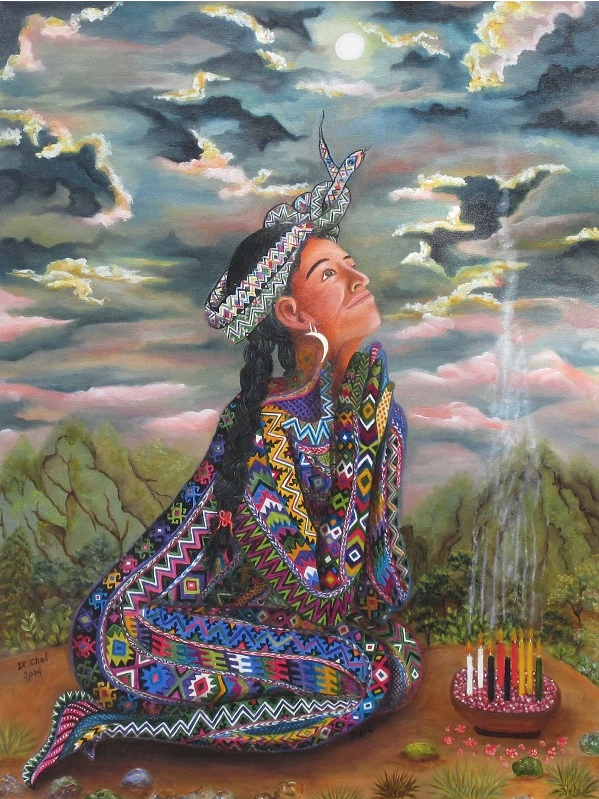
女神イクシェル
キャンバスに油彩
2002年、31.5 x 23.5インチ
アーティストのコメント イクスのエネルギーは太陽を呼び起こす。 イクスは女性のエネルギーである。 また、強さ、決意、そしてジャガーを表している。 イクスは、私たちが踊り、花、ろうそくで祝う母なる大地である。
Maya Woman, The Helen Moran Collectio
リ ンク
文 献
そ の他の情報
Copyleft, CC, Mitzub'ixi Quq Chi'j, 1996-2099
☆
 ☆
☆
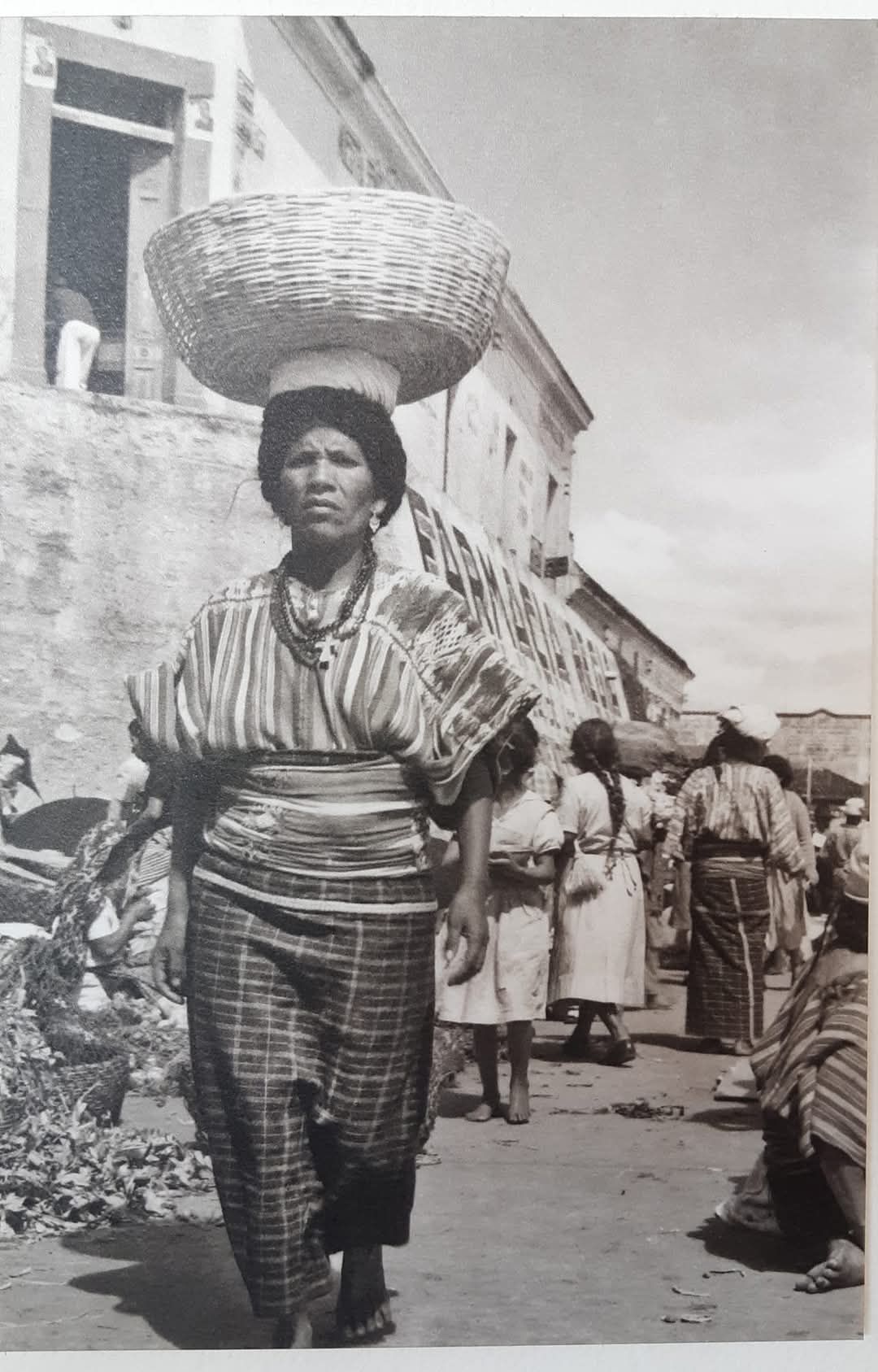
San Juan Sacatepéquez, by Jorge F. Guillemin, n.d.
